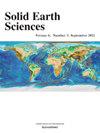西苏拉威西阿当火山地球化学:揭示望加锡海峡开口的构造演化
IF 2
4区 地球科学
Q3 GEOSCIENCES, MULTIDISCIPLINARY
引用次数: 0
摘要
望加锡海峡位于印度尼西亚中部,是印度尼西亚西部和东部的分水岭,关于它的形成一直是争论的主题。提出了两种主要理论:(1)望加锡海峡的开口形成了洋中脊(MOR)并导致了双俯冲;(2)望加锡海峡的开口是在地幔柱岩浆作用下通过陆内裂谷作用形成的。本文介绍了位于望加锡海峡东侧的西苏拉威西岛阿当火山群的发现,该火山群暴露于中新世中晚期,夹杂着结晶灰岩和碳酸盐岩,表明其与海洋环境有关。研究的岩石以低硅质基性岩为主,主要由含亮晶石/伪亮晶石的粗粒凝灰岩、粒状火山角砾岩、熔岩、过碱性岩脉以及多重基性和亮晶石侵入体组成。对阿当火山12个含白晶石岩心样品的地球化学分析表明,阿当火山岩心具有碱性,其特征是TiO2相对于Al2O3含量较高[TiO2 >;(−1.1610 + 0.1935 × Al2O3)]。样品还具有Nb/Zr >的地球化学特征;0.0627, Th/Nb >;0.67, Nb/Y比值高(>0.6561),富集轻稀土元素(LREE);洛杉矶/ Yb比;低Nb/La <;0.6,低钽负异常(δTa 0.36 ~ 0.41),表明岩浆活动产生于大陆伸展伸展构造,而非俯冲弧相关或成熟大陆裂谷,岩浆活动是由伸展过程中的减压熔融引发的。此外,岩浆活动被认为起源于富集的次大陆岩石圈地幔(SCLM)的部分熔融,而与软流圈地幔的来源无关。我们认为,阿当火山的形成过程是古近纪至新近纪早期印尼中部望加锡海峡开放的构造过程的产物。本文章由计算机程序翻译,如有差异,请以英文原文为准。
Geochemistry of the Adang Volcanics in Western Sulawesi: Unveiling the tectonic evolution of the opening of the Makassar Strait
The Makassar Strait, located in central Indonesia, serves as a divider between Western and Eastern Indonesia and remains a subject of ongoing debate regarding its formation. Two primary theories have been proposed: (1) the Makassar Strait opening established a mid-ocean ridge (MOR) and led to a double subduction, and (2) it was formed through intracontinental rifting accompanied by mantle-plume magmatism. In this study, we present findings on the Adang Volcanic Complexes in Western Sulawesi, situated on the eastern side of the Makassar Strait, which have exposures of the Middle to Late Miocene age interspersed with crystalline limestone and carbonate rocks, indicating a correlation with a marine environment. The rocks investigated in this study are predominantly low-silica mafic rock, mainly composed of leucite/pseudoleucite-bearing trachytic tuff, agglomerate volcanic breccia, lavas, peralkaline dykes, and multiple mafic and leucitic intrusions. Geochemical analysis of the 12 drill core samples of leucite-bearing Adang Volcanics reveals their alkaline nature, characterized by high TiO2 relative to Al2O3 [TiO2 > (−1.1610 + 0.1935 × Al2O3)]. The samples also display geochemical signatures of Nb/Zr > 0.0627, Th/Nb > 0.67, a high ratio of Nb/Y (>0.6561) with an enrichment of light rare earth elements (LREE; La/Yb > 20), low Nb/La <0.6, and a low negative Tantalum anomaly (δTa 0.36–0.41), suggesting the magmatism was generated from the tectonics of continental extension stretching rather than subduction arc-related or mature continental rifts, where the magmatism was triggered by decompression melting during the extensional processes. Furthermore, the magmatism is thought to originate from partial melting of enriched subcontinental lithospheric mantle (SCLM), which is uncorrelated with the source of asthenospheric mantle. We propose that the formation process of the Adang Volcano is a product of the tectonic processes of the Makassar Strait opening in Central Indonesia during the Paleogene to the Early Neogene era.
求助全文
通过发布文献求助,成功后即可免费获取论文全文。
去求助
来源期刊

Solid Earth Sciences
GEOSCIENCES, MULTIDISCIPLINARY-
CiteScore
3.60
自引率
5.00%
发文量
20
审稿时长
103 days
 求助内容:
求助内容: 应助结果提醒方式:
应助结果提醒方式:


